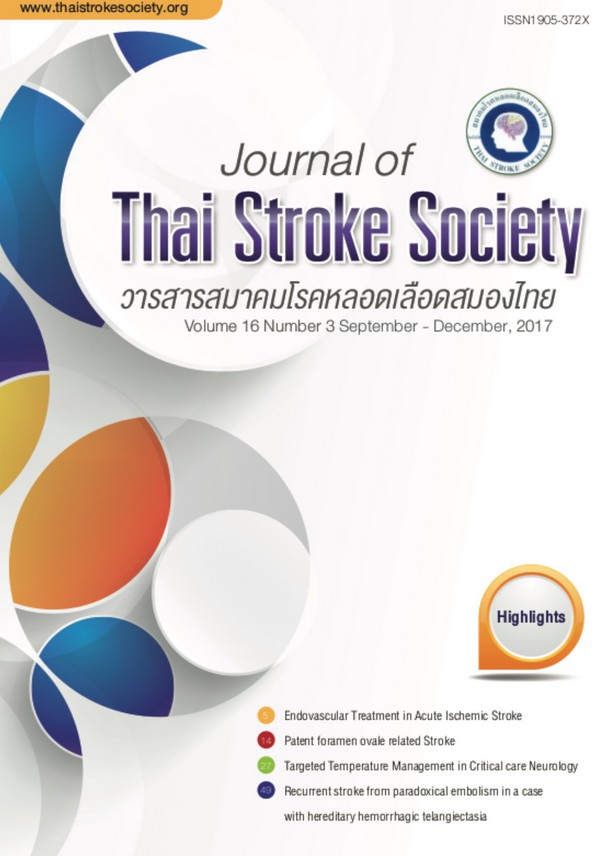Recurrent stroke from paradoxical embolism in a case with hereditary hemorrhagic telangiectasia
Keywords:
Rendu Osler Weber, hereditary hemorragic telangiectasia, pulmonary arteriovenous malformation, recurrent ischemic stroke, TCD bubble test, right to left shuntAbstract
Rendu Osler Weber or Hereditary Hemorrhagic Telangiectesia (HHT) is an autosomal dominant genetic disorder causing abnormal development of vasculature characterized by telangiectases and arteriovenous malformations of specific organs. The most common presentation of HHT is epistaxis; however ischemic stroke occasionally occurs due to paradoxical shunt such as pulmonary ateriovenous malformation (PAVM). We reported a 37-year-old woman presenting with recurrent ischemic stroke as a result of paradoxical emboli from PAVMs. The patient was brought to emergency department and the examination revealed left facial palsy and left hemiplegia. The CT angiography demonstrated complete occlusion of the distal right M1 MCA. Transcranial Doppler showed positive microbubble examination with suspected extracardiac shunts corresponding with positive bubble test from transesophgeal echocardiogram. Pulmonary angiography demonstrated 3 PAVMs and the shunts were successfully embolized. The patient was disabling due to large volume of the right MCA infarction
References
Begbie ME, Wallace GM, Shovlin CL. Hereditary haemorrhagic telangiectasia (Osler-Weber-Rendu syndrome): a view from the 21st century. Postgrad Med J.
2003;79(927):18-24.
Román G, Fisher M, Perl DP, Poser CM. Neurological manifestations of hereditary hemorrhagic telangiectasia (Rendu-Osler-Weber disease): report of 2 cases
and review of the literature. Ann Neurol. 1978;4(2):130-44.
Teague SM, Sharma MK. Detection of paradoxical cerebral echo contrast embolization by transcranial Doppler ultrasound. Stroke. 1991;22(6):740-5.
Manawadu D, Vethanayagam D, Saqqur M, Derksen C, Choy J, Khan K. Screening for right-to-left shunts with contrast transcranial Doppler in hereditary
hemorrhagic telangiectasia. Stroke. 2011:Stroke.
Shovlin CL, Guttmacher AE, Buscarini E, Faughnan ME, Hyland RH, Westermann CJ, et al. Diagnostic criteria for hereditary hemorrhagic telangiectasia (Rendu-
Osler-Weber syndrome). Am J Med Genet. 2000;91(1):66-7.
AAssar OS, Friedman CM, White RI. The natural history of epistaxis in hereditary hemorrhagic telangiectasia. Laryngoscope. 1991;101(9):977-80.
Pierucci P, Lenato GM, Suppressa P, Lastella P, Triggiani V, Valerio R, et al. A long diagnostic delay in patients with Hereditary Haemorrhagic Telangiectasia:
a questionnaire-based retrospective study. Orphanet J Rare Dis. 2012;7:33.
Kjeldsen AD, Oxhøj H, Andersen PE, Elle B, Jacobsen JP, Vase P. Pulmonary arteriovenous malformations: screening procedures and pulmonary angiography in patients with hereditary hemorrhagic telangiectasia. Chest. 1999;116(2):432-9.
Faughnan ME, Palda VA, Garcia-Tsao G, Geisthoff UW, McDonald J, Proctor DD, et al. International guidelines for the diagnosis and management of hereditary
haemorrhagic telangiectasia. J Med Genet. 2011;48(2):73-87.
Downloads
Published
How to Cite
Issue
Section
License
ข้อความภายในบทความที่ตีพิมพ์ในวารสารสมาคมโรคหลอดเลือดสมองไทยเล่มนี้ ตลอดจนความรับผิดชอบด้านเนื้อหาและการตรวจร่างบทความเป็นของผู้นิพนธ์ ไม่เกี่ยวข้องกับกองบรรณาธิการแต่อย่างใด การนำเนื้อหา ข้อความหรือข้อคิดเห็นของบทความไปเผยแพร่ ต้องได้รับอนุญาตจากกองบรรณาธิการอย่างเป็นลายลักษณ์อักษร ผลงานที่ได้รับการตีพิมพ์ในวารสารเล่มนี้ถือเป็นลิขสิทธิ์ของวารสาร





